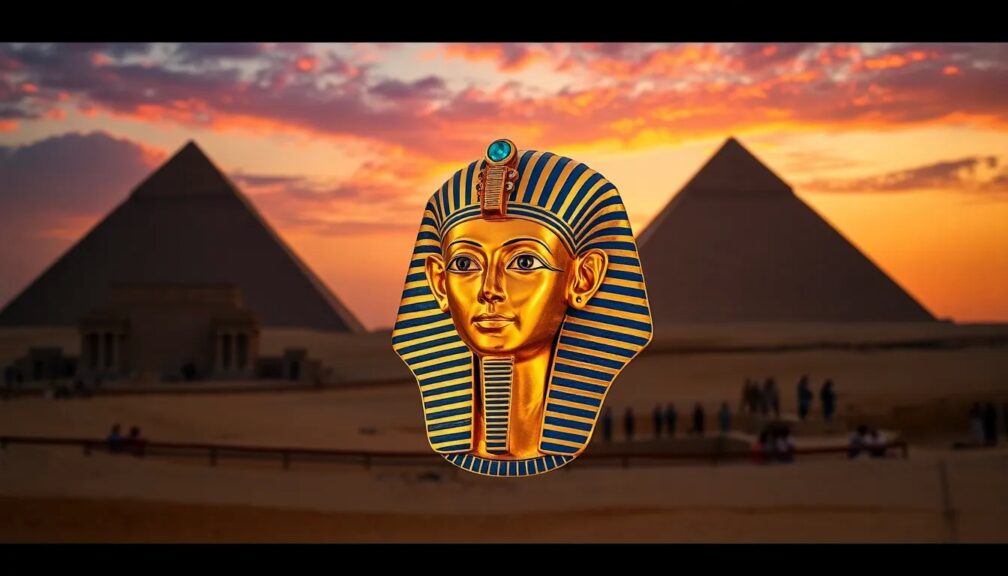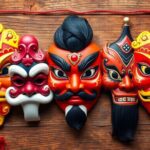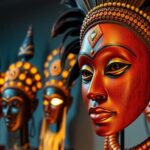History of Funerary Masks in Ancient Egypt

Few artifacts capture the imagination quite like the ancient Egyptian funerary mask. These stunning creations, often adorned with gold and precious stones, served not only as protective coverings for the deceased but also as a powerful symbol of their journey to the afterlife. The most famous of these is undoubtedly the death mask of Tutankhamun, discovered in 1922, which has become an iconic representation of ancient Egypt's rich burial traditions and beliefs about life after death. The intricate designs and craftsmanship of these masks reveal a great deal about the culture, religion, and social structures of ancient Egyptian civilization.
This exploration will delve into the multifaceted world of masks in ancient Egypt, examining their historical significance, cultural implications, and the rituals surrounding their use. We will uncover the various types of Egyptian masks, their connections to deities, and the beliefs that guided their creation and use in funerary practices. Through this journey, we will gain insights into how these masks not only served as a means of honoring the dead but also as a bridge between the earthly realm and the divine.
The Historical Context of Masks in Ancient Egypt
The use of masks in Egypt dates back thousands of years, with evidence of their existence found in archaeological sites from the Early Dynastic Period (c. 3100–2686 BCE) to the Ptolemaic Period (c. 332–30 BCE). Masks were employed not only in funerary contexts but also during various rituals and ceremonies. They were crafted from a range of materials, including wood, linen, and plaster, with elite individuals often adorned with masks made from gold and semi-precious stones.
In ancient Egyptian society, the concept of the afterlife was deeply intertwined with everyday life. The Egyptians believed in an eternal existence beyond death, where the soul would continue its journey. This belief system spurred the creation of elaborate burial practices, including the use of funerary masks. Such masks served to protect the deceased's identity and to provide them with a face in the afterlife, ensuring they would be recognized by the gods and their loved ones.
The most famous example, the pharaoh death mask of Tutankhamun, is a testament to the sophistication of ancient Egyptian artistry. Crafted from gold, inlaid with lapis lazuli, and adorned with colorful glass, this mask encapsulates the grandeur of the Egyptian civilization. It signifies the importance placed on the afterlife and the belief that the deceased would need their identity preserved in order to thrive in the next world.
The Function of Funerary Masks
The primary purpose of an Egyptian funerary mask was to serve as a protective covering for the deceased. These masks were designed to ensure that the individual's identity was preserved during their journey into the afterlife. In many cases, the masks were created to resemble the deceased, allowing them to be recognized by their soul, family members, and the gods they would encounter in the afterlife.
Beyond their protective function, death masks in ancient Egypt were also imbued with symbolic meaning. The features of the masks often reflected the ideals of beauty and divinity, showcasing the deceased in a manner that transcended their earthly existence. It was believed that these masks could help the soul navigate the trials of the afterlife, providing comfort and reassurance during the journey.
In addition to their protective and symbolic roles, funerary masks served a practical purpose in burial practices. They were often placed over the head of the mummy, providing a visual connection to the deceased that could be visited by family members during rituals. This allowed for a continued bond between the living and the dead, reinforcing the belief in the interconnectedness of life and the afterlife.
Types of Masks in Ancient Egypt
Within the realm of Egyptian masks, there are various types, each serving unique purposes and functions. The most common types include death masks, ceremonial masks, and deity masks. Each type carries its own set of meanings and significance, deeply rooted in the cultural practices of ancient Egypt.
Death masks are perhaps the most well-known, primarily associated with the burial of pharaohs and elite individuals. These masks were crafted to reflect the likeness of the deceased and were often made from precious materials, symbolizing their status and importance in society. The exquisite detailing, particularly in the case of royal death masks, indicates the reverence held for the individual being honored.
Ceremonial masks were used in various rituals and festivities, often depicting gods, goddesses, and other deities. These masks played a crucial role in religious ceremonies, allowing priests and participants to embody the divine beings they were honoring. For instance, masks representing Egyptian gods such as Osiris or Anubis were utilized during funerary rites to invoke protection and guidance for the deceased.
Deity masks, on the other hand, were designed to represent specific gods and goddesses. These masks allowed individuals to connect with the divine during rituals and offerings. The symbolism behind these masks is profound, as they embody the beliefs and values of ancient Egyptian spirituality. Each mask, adorned with specific iconography and colors, conveyed messages about the deity's powers and functions, enriching the spiritual experience of the worshippers.
The Symbolism Behind Egyptian Masks
The symbolism surrounding Egyptian masks is rich and multifaceted, deeply intertwined with the culture's beliefs about life, death, and the afterlife. Masks were not merely artistic expressions; they were powerful embodiments of religious and cultural ideologies.
One of the most significant symbols associated with ancient Egyptian masks is the concept of protection. The masks were believed to shield the soul from malevolent forces and ensure safe passage to the afterlife. This belief was particularly prevalent in the context of the Egyptian funerary mask, where the face of the deceased was transformed into a divine representation, ensuring their acceptance among the gods.
Color played a crucial role in the symbolism of masks as well. For example, gold was often used in death masks to signify purity, divinity, and immortality. The use of blue and green, colors associated with rebirth and regeneration, was prevalent in the depiction of gods and the afterlife. These colors not only enhanced the aesthetic appeal of the masks but also conveyed deeper meanings tied to the beliefs of ancient Egyptians.
Furthermore, the intricate designs and iconography found on Egyptian masks often contained references to the deceased's life and achievements. For instance, the presence of specific symbols, such as the scarab beetle representing resurrection, served to communicate the individual's virtues and their connection to the divine. This layering of symbolism in masks enriched the cultural narrative surrounding death and the afterlife, encompassing the beliefs that governed ancient Egyptian life.
The Craftsmanship of Egyptian Masks
The artistry involved in creating ancient Egyptian masks is nothing short of extraordinary. Skilled artisans devoted their lives to mastering the techniques required to create these intricate pieces. The craftsmanship reflects the high regard in which these masks were held, as they served as vital components of funerary practices.
One of the most notable aspects of the craftsmanship is the use of materials. Gold, lapis lazuli, and other precious stones were often incorporated into Egyptian funerary masks to enhance their beauty and significance. The combination of these materials not only elevated the masks' aesthetic qualities but also symbolized the wealth and status of the deceased. The meticulous attention to detail in the craftsmanship ensured that each mask was unique, capturing the essence of the individual it represented.
The techniques employed in the creation of masks varied depending on the period and the resources available. During the New Kingdom, for example, the use of gilded materials became more prevalent, resulting in the iconic gold death masks associated with pharaohs. The artisans often employed methods such as repoussé, where metal was shaped and molded to create intricate designs, and inlay work, where colored stones were embedded into the surface to enhance visual elements.
Moreover, the craftsmanship extended beyond the physical creation of the masks. The spiritual beliefs of the artisans played a significant role as well. Each mask was imbued with prayers and intentions, reflecting the artisans' hopes for the deceased in the afterlife. This intertwining of artistry and spirituality created a profound connection between the masks and the cultural practices of ancient Egypt, allowing these objects to transcend mere artifacts and become vessels of belief.
Masks and Rituals in Ancient Egyptian Society
The use of masks in ancient Egypt extended beyond funerary practices; they were integral to various rituals and ceremonies that unfolded throughout the year. These masks facilitated the connection between the earthly realm and the divine, allowing participants to engage more deeply with their spirituality.
During significant religious festivals, such as the Opet Festival, masks were donned by priests and worshippers to embody the gods they were honoring. This practice allowed individuals to connect with the divine essence of the deities, fostering a sense of communion between the spiritual and earthly realms. The act of wearing a mask during these rituals created a transformative experience, enabling participants to transcend their ordinary existence and enter a sacred space.
In addition to festivals, masks played a pivotal role in funerary rituals. The funerary masks ancient Egypt used were often incorporated into the mummification process to ensure that the deceased's identity was preserved. The rituals surrounding death were elaborate, involving prayers, offerings, and the recitation of spells from the Book of the Dead. These masks served as a focal point during these ceremonies, allowing mourners to pay their respects and seek blessings for the departed.
The significance of masks in ancient Egypt can also be seen in the context of daily life. Certain masks were used in theatrical performances that depicted myths and stories from Egyptian mythology. These performances served to educate the populace about their beliefs and cultural heritage, reinforcing the values and traditions of ancient Egyptian society. The masks worn during these performances not only enhanced the visual spectacle but also served to honor the gods and convey important teachings to the audience.
The Legacy of Egyptian Masks
The legacy of ancient Egyptian masks continues to resonate today, offering insights into a civilization that thrived for millennia. The fascination with these artifacts has inspired countless studies, exhibitions, and artistic interpretations throughout history. They serve as powerful reminders of the beliefs and practices that defined ancient Egyptian society.
The discovery of death masks in ancient Egypt, particularly the remarkable find of Tutankhamun's mask, has garnered international attention, fueling interest in the culture and its rich history. These masks are not merely relics of the past; they embody the intersection of art, spirituality, and the quest for immortality. Each mask tells a story, revealing the aspirations, fears, and beliefs of a society that placed great emphasis on the afterlife.
Furthermore, the impact of ancient Egyptian masks extends beyond the realm of archaeology and history. They have inspired contemporary artists, designers, and filmmakers, serving as a source of creativity and innovation. The visual language of these masks continues to influence modern aesthetics, as artists reinterpret their forms and meanings in new contexts.
In popular culture, the allure of Egyptian masks persists, captivating audiences through literature, cinema, and art. The mystique surrounding these artifacts ignites curiosity and a desire to explore the ancient world. The masks of the pharaohs, with their intricate designs and symbolism, invite us to ponder the questions of life, death, and what lies beyond.
By understanding the significance of Egyptian masks, we can appreciate the cultural and spiritual dimensions of ancient Egyptian life. They serve as windows into a civilization that cherished beauty, spirituality, and the eternal journey of the soul, reminding us of our own human connections to the past and the mysteries that lie ahead.



